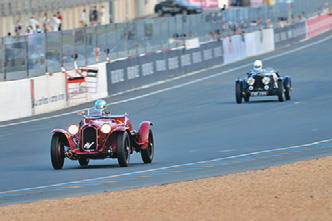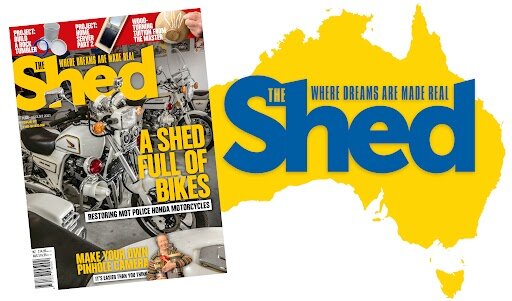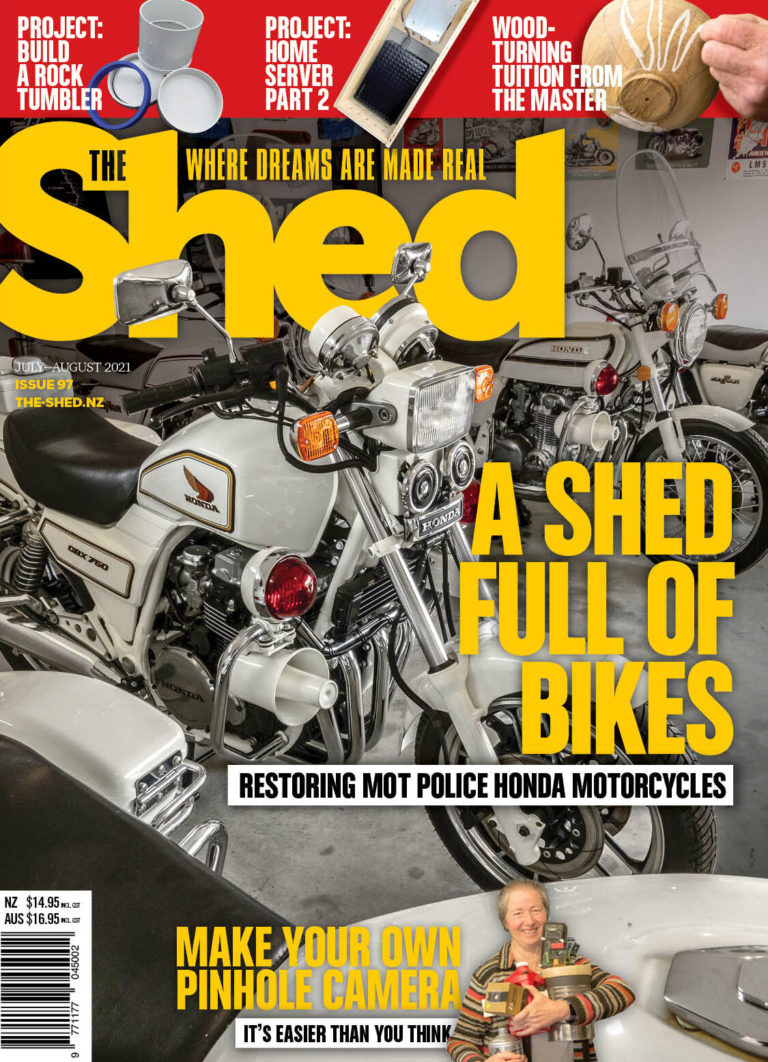A 113-year-old car restored to glory
By Ray Cleaver
Photographs by Rob Tucker and Ray Cleaver
The Experts
The restoration of the rare Arrol Johnston car is the work of five specialists who are experts in their fields. They are taking the vehicle from being a total wreck with no body to a gleaming showpiece that will look like the day it was created 113 years ago.
The work is being done in centres in Taranaki. The motor and running gear is the responsibility of restorer Roy King of Kaponga. The metalwork—body panels, firewall, mudguards, bonnet etc—were made up by Ken Arthur of Toko. Coachbuilder Neil Carter in Normanby has created the wooden body from scratch. Nigel Fraser of Classic Auto Repaints in Opunake painted the body and panels. A Taranaki upholsterer will complete the restoration. When the car is finished it will be shipped to its owner in Scotland.
Restoring a 1906 Arrol Johnston
Many of the old crafts that had been around for centuries have been almost lost in our modern age. Among them are the crafts of those who used hand tools and tapped into centuries of passed-down knowledge, the blacksmith, the wheelwright and the coachbuilder.
Coachbuilding with wood has been around for more than 500 years. The restoration of vintage cars is helping keep this craft alive in New Zealand—just—and there are only a few people here who still have these skills. One is Neil Carter of Normanby in South Taranaki. He specialises in restoring veteran cars (made before the end of 1918). These vehicles had wooden frames and bodies made by coachbuilders in the days when the horse and carriage ruled the highways.
We caught up with Neil, his skills and his current project: the complete restoration of the body of a 1906 Arrol Johnston, a car made in Scotland and one of only two left in the world. William Arrol, a Scottish engineer, was famous for building the massive Forth Bridge near Edinburgh in Scotland and he made cars from the 1890s to the 1930s. The Scottish owner of the car which is currently in Taranaki is sparing no expense to restore the vehicle to its original condition. The other existing model of this car is in a museum in Scotland.
View from the passenger’s seat as the build develops.
Challenge
The challenge of this job has been to build the complete wooden body of a 107-year-old horseless carriage from scratch, using only a drawing as a guide. The project started with a bare chassis with a wheel in each corner and an old picture that Neil was given to work from. In the days before metal-bodied cars, the framing and skin of the car was all wood and Neil is building up the entire body. He believes the wooden body is the same weight as a metal body and says in the old days people often bought a car with a chassis and running gear and then took it to a coachbuilder to have a body made to order.
“Each coachbuilder had their own style. Many car bodies were thus custom-made.”
The first step in restoring the Arrol Johnston was to make a small wooden mock-up of the body of the car using bits of wood and dowel. From this model, Neil mapped out the shape by attaching sheets of chipboard to the side of the vehicle and drawing up the life-size dimensions.
“The only photo we were given was of a double landaulet Arrol Johnston. This one is a single landaulet, so we had to modify.”
A landaulet is usually a car with a convertible roof for the passengers and a fixed roof for the driver.
The only photograph that coachbuilder Neil Carter had to work from.
Neil’s original photos of bodywork plans drawn on attached chipboard panels.
The hinged body tips backwards. The petrol tank is under the seat.
“The chassis has a shorter wheelbase than the car in the photo, which meant a few challenges,” Neil said. “As well as estimating the length and shape of the body, I had to extend the curved wall behind the driver to allow for more room. The chauffeur’s seating was very small and the new owner wants to drive it himself so I’ve had to enlarge that area. “This is really an Edwardian car. It has style and lines from the early 20th century and that makes restoration interesting.”
He has designed Edwardian scrollwork and patterns to match that era.
“Early coachbuilders were used to making fancy work on gigs and carriages and this carried on with motor vehicles,” said Neil.
Neil sharpening the scraper with an old chisel.
Neil’s two essential hand tools – a spokeshave and a scraper.
Using the scraper – better than sandpaper.
Ash
For the framing Neil uses American Ash, imported from the United States.
“A lot of early cars and coaches were built with ash. It’s very strong and stable and doesn’t move in cold and hot weather. New Zealand native timbers move a lot but the ash is dependable and strong in every direction. I also have to be careful with humidity and the car had to be painted before winter.”
Neil uses his bandsaw to cut the wood to size. Another handy tool is a spindle moulder, a large, bench-mounted inverted router that takes different blades to make the mouldings and do the finish work.
He then gets into the hand work. Like the artisans of old he uses simple tools and experience. His most-used tools are an old spokeshave (hard to find these days) and a hand scraper. His scraper is a small piece of flat steel he uses for sanding.
“It needs to be good steel. A piece of spring steel from an old saw blade is good.” Neil constantly keeps a burr on the edges of the scraper, using the side of an old chisel to rub along the edges. The burr edge shaves the wood neatly so there is no need for sandpaper.
Edwardian style of curved door.
The body is made from American ash, “very strong and stable…New Zealand native timbers move a lot.”
Glue blocks have been put along all the joins for strength.
Neil made the foldable hood bows…
…which will carry the fabric roof.
“High-tech tools don’t really fit in with this sort of work. Most joinery shops use modern gear but when you learn to use the spokeshave and scraper you don’t need a lot of electric or computerised tools—just a bit of old fashioned know-how.”
Neil says that the framework must be perfect to take the plywood outer skin. The lines and joins have to be spot-on. Where the body curves, the ply has been fitted in strips that are twisted on an angle to stop the edges protruding. The 3-ply veneer Flexiply is glued as a double skin with resorcinol pheno formaldehyde resin glue. It must be mixed before use and comes as a liquid resin and powdered catalyst. Glue blocks have been put along all the joins for strength.
“It’s a huge amount of work. It must be perfect,” said Neil. The body has to look right. I put a slight rake forward on the roof to get that right look.”
The convertible back has foldable hood bows to carry the fabric roof. Neil has made these, as well as opening glass windows between the driver and passengers.
The whole back of the body is hinged and tips backward, for what purpose Neil is unsure.
Where the body curves, the ply has been fitted in strips that are twisted on an angle to stop the edges protruding.
Old-style boot and Edwardian scrollwork
The confined chauffeur’s seating has been expanded for the new owner to drive the vehicle himself.
Neil shows hand-made latches for the vent windows between the driver and passengers.
Sitting alongside the Arrol Johnston is another project, a 1918 Cadillac Landaulet.
Engine
The car is powered by a four-litre, 18 brake horsepower engine, which is being restored by Roy King of Kaponga. Roy, who featured in an earlier edition of The Shed, is doing all the mechanical and brass work on the car.
The engine is extraordinary. It’s a four-stroke, two-cylinder, four-piston engine with opposing pistons. The two pistons in each cylinder meet in the middle. It has a four-speed gearbox and can drive the car at a maximum speed of 45 miles an hour (72 km/hr).
The Arrol Johnston model before this had the same engine but the wheels were equivalent to those of a horse cart. This was the first model to run on pneumatic tyres.
There’s no accelerator foot pedal; a lever under the steering wheel adjusts the speed. There are three brakes, one on the prop shaft and two on the wheel hubs, all operated by a hand lever like the gigs of old. Sitting alongside the Arrol Johnston is another project, a 1918 Cadillac Landaulet. It has a steel body but the framing is wood and Neil is in his element.
Neil’s business in Normanby is Furniture and Design, which he has been running since 1980. When he left high school in Hawera he was apprenticed to a furniture maker where he learned the trade.
Coachbuilding is something he began 25 years ago, teaching himself the skills needed.
He mainly makes furniture and kitchens but when an old car turns up, like the Arrol Johnston or the Cadillac, he looks forward to changing tools and rising to the challenge of rebuilding and restoring these vehicles with the arts of yesteryear.
The unusual 113-year-old engine of the Arrol Johnston car—two cylinders and four pistons. Two pistons on each side oppose the other pair like a Boxer engine with one crankshaft and two cylinder heads at opposite ends.
The plain style of rolling chassis early coachbuilders were faced with as the base for constructing the body.
The tank holding the carbide to run…
..the brass Lucas acetylene lamps. The tank was mounted on one of the running boards.
Coachbuilding
Coachbuilding is something of a lost art in New Zealand, but it has been typical of the size of enterprises which dominate our industries. Some 97.2 percent of enterprises in New Zealand have fewer than 20 employees according to the Ministry of Business, Innovation and Employment (MBIE). Of all these small-to-medium enterprises (SMEs) those with only one to five workers (97,320 enterprises) are more than double those enterprises with six to 20 employees (44, 219 enterprises).
Enterprises with fewer than 20 employees employ 30 percent of workers in New Zealand and are mostly standalone operations not owned by others.
Coachbuilding, a classic small enterprise, flourished in New Zealand in the late 19th century because importing large horse-drawn coaches was too impractical. According to the online Encyclopedia of New Zealand Te Ara, by 1916 there were 183 coachbuilders in New Zealand, employing an average of eight staff. The first cars imported into New Zealand did not immediately displace the horse and cart but the buoyant workshop industry of coachbuilding was eventually eliminated by the invention of the motor car.
Before mass production of cars was common, overseas experience saw coachbuilders who had formerly made horse carriages being asked to provide custom-designed wooden bodies for new cars. Such bodies were built on a rolling chassis with the mechanical elements in place. According to the Wikipedia history of coachbuilding, while the chassis, drive train (engine, gearbox, differential, axles, wheels), suspension and steering system were supplied by a maker, only the radiator finally identified the brand of rolling chassis under the custom-built body.
Hand-made latch secure hinged body to car floor
Nigel Fraser with newly painted firewall that sits between driver and engine.
Drinks cabinet
The dashboard and drinks cabinet is made from 80 year-old mahogany veneer which coachbuilder Neil Carter picked up 30 years ago at a joinery firm’s clearout sale. The mahogany drinks cabinet is a work of art on its own. The artwork on the front is from a vintage piano and the glasses sit in swivel holders to make sure nothing is spilt while driving.
Antarctica
One of the more bizarre instances of motor vehicle history involved an Arrol Johnston car on the ice with Ernest Shackleton’s British Antarctic (“Nimrod”) Expedition 1907-09. The Christchurch-based Antarctic Heritage Trust reports Shackleton’s transport included the “specially designed” 12-15 horse-power New Arrol Johnston fitted with an air-cooled, four-cylinder engine. Adaptations were the use of Price’s non-freezing oil, a silencer to act as a foot warmer, the exhaust pipe heating a hopper filled with snow to provide hot water, wheels of special patterns, standard car wheels with conventional rubber tyres and ski runners for the front wheels to rest on.
The James Caird Society, founded in 1994 to acknowledge Shackleton’s expeditions, notes the car was taken to the ice without the petrol engine being properly tested in conditions that it was likely to encounter and without a suitable system for providing traction (the heavy back wheels sank up to the axles in soft snow).
Eventually, with a ute-style, flat tray and skis mounted on the front wheels, the car provided limited functions on the flat ice, although it fulfilled the gloomy predictions of rival Norwegian Antarctic explorers when it fell into a crevasse. Canterbury Museum in Christchurch has items relating to this New Arrol Johnston car—a modified rear wheel and the snow hopper that was fitted to the exhaust to melt water. Roger Fyfe, Senior Curator Human History, says they were recovered in the 1960s from Pony Lake which is immediately adjacent to the Shackleton expedition base hut at Cape Royds. “Various minor items relating to this vehicle still remain in the ‘garage’ area outside the hut.” According to the Antarctic Heritage Trust, the full vehicle (the first car on the Antarctic continent) was loaded on the ship Nimrod for return to England but was thought to have been washed overboard as it was never unloaded in London.
The oak wheels that have been made from scratch by Vern Jensen of Fielding. The wing nuts are unscrewed and lead washers added to balance the wheels. This system was also used on such cars as Bentley and Rolls Royce up to World War II. Roy King will be machining brass hubcaps to fit onto the wheels.



